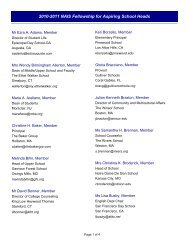History of NAIS from the Nineties to the New Millennium
History of NAIS from the Nineties to the New Millennium
History of NAIS from the Nineties to the New Millennium
You also want an ePaper? Increase the reach of your titles
YUMPU automatically turns print PDFs into web optimized ePapers that Google loves.
crucial <strong>to</strong> success. They spoke out; <strong>the</strong>y encouraged o<strong>the</strong>r <strong>to</strong> speak; <strong>the</strong>y insisted that<br />
each trustee keep in <strong>to</strong>uch with <strong>the</strong> people whom <strong>the</strong>y represented; <strong>the</strong>y s<strong>to</strong>od tall when<br />
times were most difficult; <strong>the</strong>y were models <strong>of</strong> independent school leadership: John<br />
Ratté, Karan Merry, Dick Drew, Paul Pressly. Was <strong>the</strong>re a single time in those 10 years<br />
when <strong>the</strong>y were not available for consultation? When <strong>the</strong>y failed <strong>to</strong> do <strong>the</strong>ir homework<br />
and <strong>to</strong> prepare for meetings and conferences and confrontations? When <strong>the</strong>y refused <strong>to</strong><br />
take <strong>the</strong> lead? No, <strong>the</strong>re was not a single instance. (But I do recall that Dick was<br />
somewhat reluctant <strong>to</strong> become chair; Karan convinced him <strong>to</strong> succeed her as board chair<br />
at a Red Sox game at Fenway Park.)<br />
And third, for organizational purposes, I will use both a <strong>the</strong>matic approach <strong>to</strong> this essay<br />
and <strong>the</strong> annual reports as a guide <strong>to</strong> this journey through <strong>the</strong> years. Undoubtedly, <strong>the</strong>re<br />
are people and <strong>to</strong>pics omitted that will disappoint some <strong>of</strong> you; I apologize for any<br />
omissions – it sure is difficult <strong>to</strong> include everything. But let’s try…<br />
THE BEGINNING<br />
At <strong>the</strong> beginning, when <strong>the</strong> <strong>NAIS</strong> board <strong>of</strong> direc<strong>to</strong>rs <strong>of</strong>fered me <strong>the</strong> presidency, <strong>the</strong> chair,<br />
John Ratté, asked me how long all that we discussed might take <strong>to</strong> accomplish. “Ten<br />
years,” I responded, and John, always quick and on <strong>the</strong> mark, asked if I would accept a<br />
10- year contract.<br />
After <strong>the</strong> laughter <strong>from</strong> <strong>the</strong> rest <strong>of</strong> <strong>the</strong> board, we became almost <strong>to</strong>o serious. Aware that<br />
my selection was controversial – I had been a public school administra<strong>to</strong>r and<br />
superintendent for <strong>the</strong> previous 18 years, however much my career was rooted in<br />
independent schools – I asked <strong>the</strong> board <strong>to</strong> express unanimity in my selection. In effect,<br />
each board member had ve<strong>to</strong> power, I said. We needed <strong>to</strong> be <strong>to</strong>ge<strong>the</strong>r for <strong>the</strong> sake <strong>of</strong> <strong>the</strong><br />
association; on this point, <strong>the</strong> entire board needed <strong>to</strong> support <strong>the</strong> selection and speak with<br />
one voice. Fortunately, and happily for me, <strong>the</strong> direc<strong>to</strong>rs agreed and I accepted <strong>the</strong>ir<br />
invitation.<br />
While I began my duties <strong>of</strong>ficially on July 1, 1991, <strong>the</strong>re were many opportunities in <strong>the</strong><br />
preceding four months that immediately provided insight in<strong>to</strong> <strong>NAIS</strong>’s strength and<br />
potential – and problems. I attended <strong>the</strong> Annual Conference and <strong>New</strong> Heads and<br />
accepted invitations <strong>to</strong> speak at <strong>the</strong> Pennsylvania Association <strong>of</strong> Independent Schools<br />
(PAIS) and <strong>the</strong> Association <strong>of</strong> Delaware Valley Independent Schools (ADVIS).<br />
Everywhere, independent school people were emphatic about <strong>the</strong>ir appreciation for<br />
<strong>NAIS</strong>’s work, but just as clearly <strong>the</strong>y expressed <strong>the</strong>ir concerns: <strong>NAIS</strong> needed <strong>to</strong> be more<br />
responsive and <strong>to</strong> be a greater presence. And <strong>the</strong> anticipation about relocating <strong>to</strong><br />
Washing<strong>to</strong>n added a dimension <strong>to</strong> our conversations that was surpassed only by <strong>the</strong> move<br />
itself. Most school administra<strong>to</strong>rs and trustees favored <strong>the</strong> move; some did not. Why<br />
not? The reluctance <strong>to</strong> change; <strong>the</strong> cost; concerns that older, traditional schools,<br />
especially in <strong>New</strong> England, would be abandoned; <strong>the</strong> idea that <strong>NAIS</strong> would be swallowed<br />
up by <strong>the</strong> Washing<strong>to</strong>n bureaucracy. But most people said, “Finally, we will be in <strong>the</strong><br />
nation’s capital. <strong>NAIS</strong> will represent all <strong>the</strong> schools and will be a symbol <strong>of</strong> independent<br />
schools, known nationally.”




